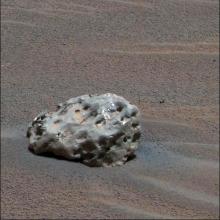You are here
Meteorites

Physicist Jean-Baptiste Biot investigated the L'Aigle events. He found that people in other villages had seen a bright fireball in the sky just before the explosion. The sequence of events left no doubt that the meteorites came from a celestial source.
Today, we know that most meteorites are pieces of asteroids (although a few come from the Moon and Mars). Collisions between asteroids break off fragments, some of which make their way to Earth. Most burn up as they plunge through the atmosphere, forming the bright streaks of light known as meteors. A few, though, survive and crash to Earth. The largest found to date, in Namibia, weighs about 60 tons.
Most meteorites are far older than the oldest rocks on Earth -- up to almost 4.6 billion years old, compared to less than 4 billion years for the oldest Earth rocks. Rain, wind, and the motions of Earth's crust have altered the rocks on our planet. But the parent asteroids of most meteorites have remained relatively unchanged since their formation, so they preserve bits of the earliest history of the solar system. Studying these objects helps scientists understand the formation of Earth and the other planets.
Meteor Meanings
Meteoroid
A small bit of rock or metal orbiting the Sun.
Meteor
A bit of debris that forms a bright streak of light as it vaporizes upon entering Earth’s upper atmosphere.
Meteorite
A space rock that survives its flight through the atmosphere and lands on the surface of Earth or another body.






